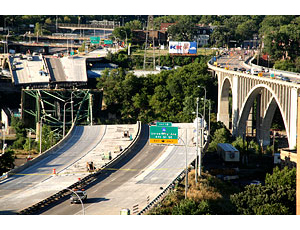It has been more than two years since the Interstate-35W bridge in Minneapolis suddenly collapsed into the Mississippi River, killing 13 people and injuring 145 others, and yet scores of lawsuits filed against firms involved in the bridge’s design and upkeep are just getting under way.

While the replacement bridge, completed last year, required the attention of more than 600 craft workers and engineers, just one state judge, Deborah Hedlund, sitting in the Hennepin County District Court, is handling all 121 pending lawsuits, which she plans to begin trying in March 2011. In an effort to keep things simple, the cases will be tried in groups of six, say lawyers involved in the proceedings.
The latest twist in what has become a complex web of legal finger-pointing came late last month, when Lori Swanson, Minnesota’s attorney general, sued consulting engineer URS Corp., San Francisco, for breach of contract, negligence and other claims. The action came several weeks after the state filed suit against local roadbuilder Progressive Contractors Inc., which was resurfacing the bridge when it collapsed, and Pasadena, Calif.-based Jacobs, which in 1999 acquired Sverdrup & Parcel, the bridge’s original designer. The state seeks to recover more than $37 million it has paid to collapse victims under a special victims’ compensation fund signed into law last year.
The state’s “shotgun approach,” as one source puts it, suddenly widened as a two-year statute of limitations was about to expire that would have barred the state from suing San Francisco-based URS, which the state hired in 2003 to examine the old structure. Until that point, Minnesota Dept. of Transportation and URS appeared to have a “fairly cozy relationship,” says Kyle Hart, PCI’s attorney.
Since the National Transportation Safety Board determined last year that the bridge collapsed due to underdesigned gusset plates, the case against URS centers on whether it was ever required to evaluate the original design. The state claims it was URS’s job to do so and quotes from a March 2006 memo in which URS said, “We will not calculate actual capacities of all of the connections since that is too much work.” URS also had deemed the bridge’s gusset plates to be in “good condition,” says the state.
URS does not deny that it made those statements but says it was not told to evaluate the design, which Sverdrup drafted and the state approved more than 40 years ago. “URS assumed that the connections, including gusset plates, met the minimum requirements of the design code in place at the time the bridge was designed,” says the firm, adding that, in July 2006, “URS explained that assumption to MnDOT.” The firm has brought PCI and Jacobs into the suit, claiming they ultimately were responsible for the collapse.
PCI has lost millions of dollars—as well as an employee who died in the tragedy—and is struggling financially as lawsuits pile up. Among other things, the state seeks to recover from PCI a $9.7-million surety bond on the collapsed bridge’s paving job. PCI claims, like URS, that it is accepted industry practice to take for granted that certified plans are designed according to code. “In Minnesota, we are entitled as a matter of law to assume that it was designed correctly,” says Hart, who also cites a 1918 U.S. Supreme Court decision in U.S. v. Spearin, in which the high court held the same.
Northbrook, Ill.-based forensic engineer Wiss, Janney, Elstner Associates Inc., which the state hired to investigate the failed bridge, mirrors Hart’s opinion. “Once a bridge is put into service and traffic is allowed on it, it must be assumed that there are no major design deficiencies. If this were not the case, it would of course be irresponsible to open the bridge,” Howard Hill, WJE’s director of operations and the man who first discovered gusset problems after the collapse, told ENR in December. NTSB’s findings were consistent with WJE’s.
Meanwhile, Jacobs’ fight hinges on how long after substantial completion a designer can be sued for malpractice. State law generally calls for a 10-year limit, but it still allows third parties like URS and PCI to sue Jacobs, legal experts say. The state’s victims compensation law also allows the state to sue Jacobs to recover damages. The firm is seeking to be dismissed from all the suits, and the judge is expected to rule by the end of the month.
Few sources doubt all the complex litigation will take years to sort out. The state did not call back ENR, but Hart thinks it does not have “any expectation of recovering a dime. I think the state is just desperate to settle this and put it behind them.”



Post a comment to this article
Report Abusive Comment